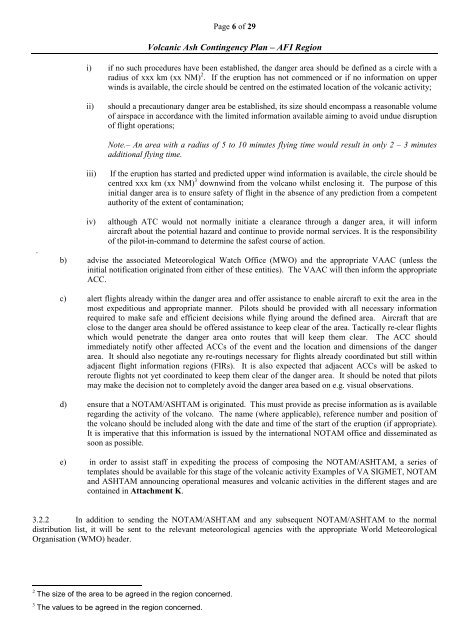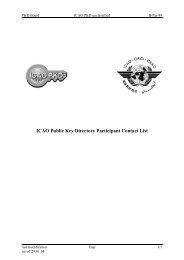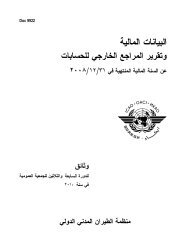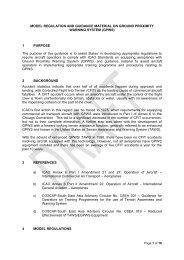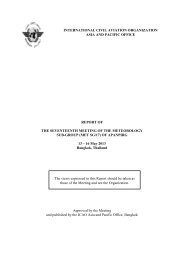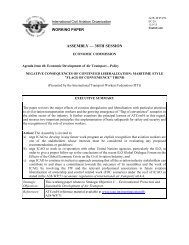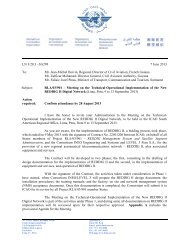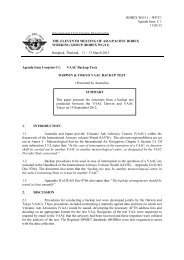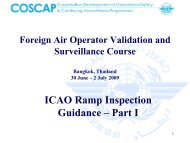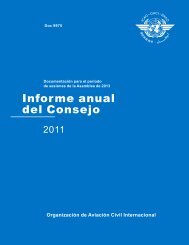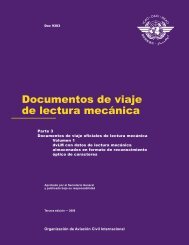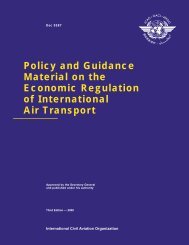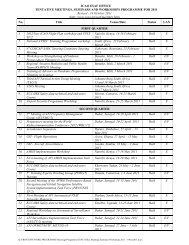afi met bulletins exchange (ambex) handbook - ICAO
afi met bulletins exchange (ambex) handbook - ICAO
afi met bulletins exchange (ambex) handbook - ICAO
Create successful ePaper yourself
Turn your PDF publications into a flip-book with our unique Google optimized e-Paper software.
.<br />
Page 6 of 29<br />
Volcanic Ash Contingency Plan – AFI Region<br />
i) if no such procedures have been established, the danger area should be defined as a circle with a<br />
radius of xxx km (xx NM) 2 . If the eruption has not commenced or if no information on upper<br />
winds is available, the circle should be centred on the estimated location of the volcanic activity;<br />
ii) should a precautionary danger area be established, its size should encompass a reasonable volume<br />
of airspace in accordance with the limited information available aiming to avoid undue disruption<br />
of flight operations;<br />
Note.– An area with a radius of 5 to 10 minutes flying time would result in only 2 – 3 minutes<br />
additional flying time.<br />
iii) If the eruption has started and predicted upper wind information is available, the circle should be<br />
centred xxx km (xx NM) 3 downwind from the volcano whilst enclosing it. The purpose of this<br />
initial danger area is to ensure safety of flight in the absence of any prediction from a competent<br />
authority of the extent of contamination;<br />
iv) although ATC would not normally initiate a clearance through a danger area, it will inform<br />
aircraft about the potential hazard and continue to provide normal services. It is the responsibility<br />
of the pilot-in-command to determine the safest course of action.<br />
b) advise the associated Meteorological Watch Office (MWO) and the appropriate VAAC (unless the<br />
initial notification originated from either of these entities). The VAAC will then inform the appropriate<br />
ACC.<br />
c) alert flights already within the danger area and offer assistance to enable aircraft to exit the area in the<br />
most expeditious and appropriate manner. Pilots should be provided with all necessary information<br />
required to make safe and efficient decisions while flying around the defined area. Aircraft that are<br />
close to the danger area should be offered assistance to keep clear of the area. Tactically re-clear flights<br />
which would penetrate the danger area onto routes that will keep them clear. The ACC should<br />
immediately notify other affected ACCs of the event and the location and dimensions of the danger<br />
area. It should also negotiate any re-routings necessary for flights already coordinated but still within<br />
adjacent flight information regions (FIRs). It is also expected that adjacent ACCs will be asked to<br />
reroute flights not yet coordinated to keep them clear of the danger area. It should be noted that pilots<br />
may make the decision not to completely avoid the danger area based on e.g. visual observations.<br />
d) ensure that a NOTAM/ASHTAM is originated. This must provide as precise information as is available<br />
regarding the activity of the volcano. The name (where applicable), reference number and position of<br />
the volcano should be included along with the date and time of the start of the eruption (if appropriate).<br />
It is imperative that this information is issued by the international NOTAM office and disseminated as<br />
soon as possible.<br />
e) in order to assist staff in expediting the process of composing the NOTAM/ASHTAM, a series of<br />
templates should be available for this stage of the volcanic activity Examples of VA SIGMET, NOTAM<br />
and ASHTAM announcing operational measures and volcanic activities in the different stages and are<br />
contained in Attachment K.<br />
3.2.2 In addition to sending the NOTAM/ASHTAM and any subsequent NOTAM/ASHTAM to the normal<br />
distribution list, it will be sent to the relevant <strong>met</strong>eorological agencies with the appropriate World Meteorological<br />
Organisation (WMO) header.<br />
2 The size of the area to be agreed in the region concerned.<br />
3 The values to be agreed in the region concerned.


